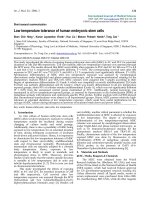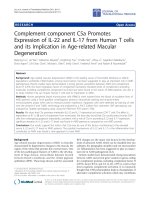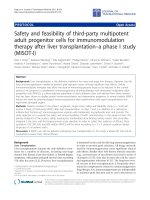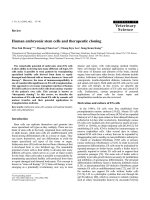Differentiation and derivation of lineage committed chondroprogenitors and chondrogenic cells from human embryonic stem cells for cartilage tissue engineering and regeneration
Bạn đang xem bản rút gọn của tài liệu. Xem và tải ngay bản đầy đủ của tài liệu tại đây (4.98 MB, 190 trang )
DIFFERENTIATION AND DERIVATION OF LINEAGE-
COMMITTED CHONDROPROGENITORS AND CHONDROGENIC
CELLS FROM HUMAN EMBRYONIC STEM CELLS FOR
CARTILAGE TISSUE ENGINEERING AND REGENERATION
TOH WEI SEONG
(M. Sc. National University of Singapore, Singapore)
A THESIS SUBMITTED
FOR THE DEGREE OF DOCTOR OF PHILOSOPHY
DEPARTMENT OF ORAL AND MAXILLOFACIAL SURGERY
NATIONAL UNIVERSITY OF SINGAPORE
2010
i
ACKNOWLEDGEMENTS
I am most grateful to my supervisors: Associate Professor Cao Tong, Vice-Dean
(Research), Department of Oral & Maxillofacial Surgery, Faculty of Dentistry, National
University of Singapore, and Professor Lee Eng Hin, Director of Graduate Medical
Studies, Department of Orthopaedic Surgery, Yong Loo Lin School of Medicine,
National University of Singapore for their countless encouragement, guidance, assistance
and patience during my PhD program. I would also like to express my heartfelt gratitude
to Dr. Andre Choo, Senior Research Scientist, Stem Cell Group, Bioprocessing
Technology Institute, A*STAR, for his guidance and critical discussion of my work, as
well as Dr. Guo Xi-min, Research Scientist, Department of Tissue Engineering &
Regenerative Medicine, Beijing Institute of Basic Medical Sciences for his help in animal
transplantation studies. Last but not least, I would also like to express my sincere thanks
to Assistant Professor Jerry Chan, Experimental Fetal Medicine Group, Yong Loo Lin
School of Medicine, National University of Singapore, for his advice on human
chimerism studies and assistance in manuscript preparation.
Thanks to all my trusted colleagues in Stem Cell Lab, Department of Oral &
Maxillofacial Surgery- Liu Hua, Fu Xin, Lu Kai, Li Mingming and Vinoth Kumar
S/O Jayaseelan for their support and endless concern throughout the course of my work.
Not forgetting to mention my colleagues and friends in NUS Tissue Engineering
Program- Hossein Nejadnik, Yeow Chen Hua, See Kwee Hua, Angela Tan Hwee San,
ii
Afizah Hassan and Julee Chan. Without them, my research would not have been so
enjoyable.
Last but not least, I am grateful to my families, my parents and parent-in-laws, my wife
Saw Tzuen Yih for their understanding, patience and great support during the years of
my PhD pursuit.
iii
TABLE OF CONTENTS
ACKNOWLEDGEMENTS……………………………………………………… i
TABLE OF CONTENTS………………………………………………… iii
SUMMARY……………………………………………………………………… xi
LIST OF TABLES…………………………………………………………………xiv
LIST OF FIGURES………………………………………………………………. xv
LIST OF ABBREVIATIONS……………………………………………………. xvii
CHAPTER 1
1. INTRODUCTION…………………………………………………………1
1.1 Objectives………………………………………………………………… 2
CHAPTER 2
2. LITERATURE REVIEW…………………………………………………4
2.1 Articular cartilage and its associated clinical problems……………………. 4
2.2 Human Embryonic Stem Cells (hESCs)…………………………………… 7
2.2.1 Expansion of hESCs……………………………………………… 8
2.3 Differentiation of hESCs into chondrogenic lineage………………………. 10
2.3.1 Direct chondrogenic differentiation with EB formation…………… 11
2.3.1.1 Growth factor induction……………………………………………. 12
2.3.1.2 Co-culture………………………………………………………… 13
2.3.1.3 Challenges in the EB differentiation system……………………… 14
iv
2.3.2 Direct chondrogenic differentiation without EB formation……… 15
2.3.2.1 Growth factor induction……………………………………………. 15
2.3.2.2 Genetic manipulation………………………………………………. 15
2.3.2.3 Co-culture and conditioned medium………………………………. 16
2.3.3 Indirect differentiation………………………………………….……18
2.3.3.1 Chondrogenic differentiation of hESC-derived MSCs…………… 18
2.3.3.2 Chondrogenic differentiation of hESC-derived mesenchymal cells 19
2.3.4 Biomaterial-assisted chondrogenic differentiation………………… 21
2.3.4.1 Cartilage tissue engineering using hydrogels……………………… 21
2.3.4.2 Cartilage tissue engineering using polymeric scaffolds…………… 23
2.4 Cartilage formation and regeneration using ESCs………………………… 24
2.4.1 Homogeneity and differentiation of ESCs………………………… 25
2.4.2 Delivery strategy and biomaterial choice…………………………. 26
2.4.3 Site of transplantation and host cell interference………………… 28
2.5 Animal models………………………………………………………………31
CHAPTER 3
3. MATERIALS AND METHODS………………………………………… 33
3.1 Reagents, chemicals, culture media and labware consumables……………. 33
3.2 Experimental design……………………………………………………… 33
3.3 Cell differentiation…………………………………………………………. 34
3.3.1 Culture of hESCs………………………………………………… 34
3.3.2 Chondrogenic differentiation via embryoid body outgrowth culture.35
v
3.3.3 Chondrogenic differentiation via high-density micromass culture… 35
3.3.4 Isolation and expansion of hESC-derived chondrogenic cells…… 37
3.3.4.1 Culture of hESC-derived chondrogenic cells on various ECM
substratum 38
3.3.5 In vitro cartilage-like tissue formation …………………………… 39
3.3.6 Multi-lineage differentiation analysis……………………………….40
3.4 Cellular assays and cytogenetics…………………………………………… 41
3.4.1 Growth kinetics…………………………………………………… 41
3.4.2 Cell cycle analysis………………………………………………… 41
3.4.3 Surface marker analysis……………………………………………. 42
3.4.4 Multi-color fluorescence in situ hybridization (mFISH)………… 43
3.5 Molecular biology assays………………………………………………… 43
3.5.1 Total RNA extraction and cDNA synthesis……………………… 43
3.5.2 RT-PCR and real-time PCR quantitative analysis…………………. 44
3.6 Biochemical assays………………………………………………………… 46
3.6.1 Sulfated glycosaminoglycan quantification……………………… 46
3.6.2 Collagen quantification…………………………………………… 48
3.6.3 Collagen II quantification………………………………………… 48
3.6.3.1 Sample preparation………………………………………………… 49
3.6.3.2 Collagen II ELISA…………………………………………………. 49
3.6.4 DNA quantification………………………………………………… 50
3.6.5 Alkaline phosphatase (ALP) activity assay……………………… 50
3.7 Histochemical and fluorescence staining techniques………………………. 51
vi
3.7.1 Staining of cell cultures……………………………………………. 51
3.7.1.1 Alcian blue staining……………………………………………… 51
3.7.1.2 Alkaline phosphatase (ALP) staining……………………………… 51
3.7.1.3 Alizarin red S staining…………………………………………… 52
3.7.1.4 Oil red-O staining………………………………………………… 52
3.7.1.5 Immunofluorescence (IF) staining…………………………………. 53
3.7.2 Staining of tissue specimens……………………………………… 54
3.7.2.1 Processing of tissue specimens…………………………………… 54
3.7.2.2 Haematoxylin and eosin staining………………………………… 55
3.7.2.3 Alcian blue staining……………………………………………… 56
3.7.2.4 Safranin-O staining………………………………………………… 56
3.7.2.5 Masson’s trichrome staining……………………………………… 57
3.7.2.6 Immunohistochemical staining…………………………………… 57
3.8 Animal studies…………………………………………………………… 59
3.8.1 In vivo implantation assay………………………………………… 59
3.8.2 Osteochondral defect model……………………………………… 60
3.8.3 Post-operative procedures………………………………………… 61
3.8.4 Micro-computational tomography (micro-CT)…………………… 62
3.8.5 Human cell chimerism…………………………………………… 62
3.9 Statistical analysis………………………………………………………… 63
CHAPTER 4
4. RESULTS…………………………………………………………………. 65
A
vii
4.1 PHASE I: MODEL SYSTEM…………………………………………… 65
4.1.1 Pluripotency of human embryonic stem cells……………………… 65
4.1.2 Effects of culture conditions in modulation of chondrogenesis…….66
4.1.3 Effects of culture conditions on hypertrophic development……… 71
4.1.4 Modulation of chondrogenesis in different EB seeding densities…. 74
4.1.5 Effects of culture conditions in lineage selection during
chondrogenesis…………………………………………………… 75
4.2 PHASE II: GROWTH FACTOR MODULATION……………………… 76
4.2.1 Growth factor modulation of chondrogenesis……………………… 76
4.2.2 Growth factor modulation of matrix synthesis…………………… 78
4.2.3 Growth factor modulation of chondrogenic commitment…………. 81
4.2.4 TGFβ1 induction of chondrogenic cells…………………………… 83
4.3 PHASE III: ISOLATION OF CHONDROGENIC CELLS……………… 86
4.3.1 Derivation of hESC-derived chondrogenic cells………………… 86
4.3.2 Expansion of hESC-derived chondrogenic cells……………………88
4.3.3 Differentiation capability of hESC-derived chondrogenic cells…… 88
4.3.4 Characterization of hESC-derived chondrogenic cell line (TC1)… 90
4.3.5 ECM modulation of hESC-derived chondrogenic cells……………. 96
4.4 PHASE IV: FUNCTIONALITY………………………………………… 98
4.4.1 Cartilage tissue engineering using hESC-derived chondrogenic
cells………………………………………………………………… 98
4.4.1.1 Optimal growth factor induction for cartilage tissue engineering…. 98
viii
4.4.1.2 Effects of 3D HA hydrogel encapsulation in cartilaginous tissue
development……………………………………………………… 98
4.4.1.3 Human ESC-derived chondrogenic cell-engineered cartilage
(HCCEC)………………………………………………………… 100
4.4.2 Cartilage regeneration in osteochondral defect…………………… 103
4.4.2.1 Comparison of hESC-derived chondrogenic cells and HCCEC in
cartilage repair…………………………………………………… 103
4.4.2.2 HCCEC in cartilage regeneration………………………………… 106
4.4.2.3 Human cell chimerism…………………………………………… 116
4.4.3 Phenotypic stability of hESC-derived chondrogenic cells………….119
CHAPTER 5
5. DISCUSSION…………………………………………………………… 121
5.1 PHASE I: MODEL SYSTEM…………………………………………… 121
5.1.1 Human ESCs as a model system to study chondrogenesis………… 121
5.1.1.1 Chondrogenic differentiation in EB outgrowth……………………. 121
5.1.1.2 Effects of high-density microenvironment on chondrogenic
differentiation………………………………………………………. 123
5.1.1.3 Effects of high-density microenvironment on hypertrophic
maturation………………………………………………………… 125
5.1.1.4 Effects of higher EB seeding numbers on chondrogenic
differentiation………………………………………………………. 126
ix
5.1.1.5 Effects of high-density microenvironment on other lineage
differentiation………………………………………………… 127
5.2 PHASE II: GROWTH FACTOR MODULATION……………………… 129
5.2.1 Growth factor modulation of chondrogenesis……………………… 129
5.2.2 Effects of TGFβ1 on other lineage differentiation…………………. 131
5.2.3 Pluripotency vs. chondrogenesis - Role of TGFβ1………………… 131
5.3 PHASE III: ISOLATION OF CHONDROGENIC CELLS……………… 133
5.3.1 Human ESC-derived chondrogenic cells………………………… 133
5.3.1.1 Effects of growth factors and ECM on hESC-derived chondrogenic
cells………………………………………………………………… 133
5.4 PHASE IV: FUNCTIONALITY 136
5.4.1 Human ESC-derived chondrogenic cells in cartilage tissue
engineering…………………………………………………………. 136
5.4.1.1 Human ESC-derived chondrogenic cell-engineered cartilage
(HCCEC)………………………………………………………… 136
5.4.2 Human ESC-derived chondrogenic cells in cartilage regeneration 138
5.4.2.1 Osteochondral defect model……………………………………… 138
5.4.2.2 Role of HCCEC in cartilage repair………………………………… 139
5.4.2.3 Role of HCCEC in cartilage integration…………………………… 140
5.4.2.4 Orderly remodeling of HCCEC in cartilage regeneration 141
5.4.2.5 Fate of hESC-derived chondrogenic cells in cartilage regeneration 143
5.4.2.6 Phenotypic stability of hESC-derived chondrogenic cells………….145
5.4.2.7 Tumorigenicity of hESC-derived chondrogenic cells………………147
x
CHAPTER 6
6. CONCLUSION 149
CHAPTER 7
7. LIMITATIONS AND FUTURE WORK……………………………… 151
REFERENCES……………………………………………………………………. 154
PUBLICATIONS…………………………………………………………………. 168
xi
SUMMARY
Background: Articular cartilage repair is problematic due to its poor self-regenerative
ability. Cell-based therapies and tissue engineering show great potential for cartilage
repair. Human embryonic stem cells (hESCs) represent a promising cell source for
regenerative medicine because of their unlimited self-renewal and ability to differentiate
into various somatic cell lineages. However, major challenges impeding clinical
application of hESCs include safety issues of tumorigenicity and functionality upon
transplantation. To date, there is still limited understanding of the factors, signals, and
even the environment necessary to induce hESCs to specifically differentiate into the
chondrogenic lineage. Furthermore, few studies have explored the potential of hESCs and
its derivatives for cartilage tissue engineering. The ability and fate of these hESC-derived
cells in cartilage repair has not yet been addressed.
Hypothesis: The main hypothesis is that hESC-derived cells under appropriate
conditions can lead to improvement of cartilage repair.
Methods: With the aim to verify the above hypothesis, a step-wise approach was
designed. They are as follows:
Phase I: To establish hESCs as a model system to study chondrogenesis
Phase II: To understand the role of signaling growth factors in chondrogenesis
Phase III: To derive potentially clinically-compliant lineage-restricted hESC-derived
chondrogenic cell lines
xii
Phase IV: To establish the safety and functionality of hESC-derived chondrogenic
cells in ectopic and orthotopic sites in animal models in vivo.
Results: In Phase I, a well-defined full-span chondrogenesis from chondrogenic
induction to hypertrophic maturation was observed in hESC-derived embryoid bodies
plated as a high-density micromass system. These findings verified the potential of
hESCs as a model system for the study of chondrogenesis as well as its chondrogenic
potential for cartilage repair. In Phase II, TGFβ1 was identified as the pivotal growth
factor for chondrogenic differentiation of hESCs, resulting in the highest level of
cartilage gene expression and matrix synthesis. In Phase III, lineage-restricted hESC-
derived chondrogenic cell lines were derived and demonstrated to be expandable,
homogenous and unipotent in differentiation potential. These cells were functional with
ability to form cartilaginous tissue in the pellet system, and stable with a normal
karyotype and normal somatic cell cycle kinetics. In Phase IV, hESC-derived
chondrogenic cells were used in cartilage tissue engineering with hyaluronic acid
hydrogels to construct clinical-relevant size cartilage tissue constructs, which upon
implantation, observed an orderly spatial-temporal remodeling into osteochondral tissue
over 12 weeks, marked by development of characteristic architectural features including a
hyaline-like neocartilage layer with complete integration with the adjacent host cartilage
and a regenerated subchondral bone. The transplanted hESC-derived chondrogenic cells
maintained long-term viability up to 12 weeks and no evidence of tumorigenicity was
observed in both orthotopic and ectopic transplantations.
xiii
Conclusion: This study demonstrates a progressive advancement from the basic science
of establishing hESCs as a model system for chondrogenesis, understanding of the role of
signaling growth factors during chondrogenesis to translational applications of deriving
potentially clinically-compliant chondrogenic cell lines for cartilage tissue engineering
and regeneration. Thus, our study demonstrates a safe, highly-efficient and practical
strategy of applying hESCs for application in cartilage regenerative medicine.
(500 words)
xiv
LIST OF TABLES
Table 1. Biomaterials that have been used in cartilage formation and repair
Table 2. Preparation of basic serum-free chondrogenic differentiation medium
Table 3. List of growth factors
Table 4. List of antibodies for FACS
Table 5. Sequence of primers used for conventional RT-PCR
Table 6. Sequence of primers used for real-time RT-PCR
Table 7. List of antibodies for IHC and IF
Table 8. Histological grading scale
Table 9. Surface marker analysis of hESC-derived chondrogenic cells.
Table 10. Results of histological scoring of reparative tissues.
Table 11. Histological scoring results of HCCEC in cartilage repair.
xv
LIST OF FIGURES
Fig. 1. Experimental flowchart
Fig. 2. Osteochondral defect model
Fig. 3. Schematic model to illustrate the centre (C) and periphery (P) zones of the
regenerated neocartilage layer.
Fig. 4. Pluripotent hESCs.
Fig. 5. Chondrogenic differentiation in EB outgrowth and EB-derived micromass.
Fig. 6. Modulation of s-GAG synthesis in EB outgrowth and EB-derived micromass.
Fig. 7. Hypertrophic development in EB outgrowth and EB-derived micromass.
Fig. 8. Kinetics of ALP activity in EB outgrowth and EB-derived micromass.
Fig. 9. Effects of increasing EB seeding numbers on chondrogenic differentiation in an
EB outgrowth system.
Fig. 10. Lineage restriction analysis in EB outgrowth and EB-derived micromass.
Fig. 11. Growth factor modulation of chondrogenesis in EB-derived micromass.
Fig. 12. Growth factor modulation of matrix synthesis.
Fig. 13. Growth factor modulation of other lineage differentiation.
Fig. 14. TGFβ1-induced chondrogenesis.
Fig. 15. TGFβ1-induced chondrogenesis vs. pluripotency.
Fig. 16. Isolation and monolayer plating of hESC-derived chondrogenic cells.
Fig. 17. Chondrogenic differentiation capability of hESC-derived chondrogenic cells.
Fig. 18. Analysis of pluripotency and lineage-restriction of hESC-derived chondrogenic
cells.
Fig. 19. Multi-lineage differentiation analysis of hESC-derived chondrogenic cells.
xvi
Fig. 20. Cell cycle kinetics of hESC-derived chondrogenic cells.
Fig. 21. Genome integrity of hESC-derived chondrogenic cells.
Fig. 22. Tumorigenicity of hESC-derived chondrogenic cells.
Fig. 23. ECM modulation of post-expansion differentiation capability of hESC-derived
chondrogenic cells.
Fig. 24. Response of hESC-derived chondrogenic cells to anabolic growth factors of
matrix synthesis.
Fig. 25. Comparison of 3D HA hydrogel system with the pellet system.
Fig. 26. Cartilage tissue engineering using hESC-derived chondrogenic cells.
Fig. 27. Comparison of hESC-derived chondrogenic cells and HCCEC in cartilage repair.
Fig. 28. In vivo cartilage repair at 2 weeks post-implantation.
Fig. 29. In vivo cartilage repair at 6 weeks post-implantation.
Fig. 30. In vivo cartilage repair at 12 weeks post-implantation.
Fig. 31. Overall histological scoring.
Fig. 32. Micro-CT model of HCCEC remodeling process in cartilage regeneration.
Fig. 33. Human cell chimerism and survivability of hESC-derived chondrogenic cells in
vivo.
Fig. 34. Macrophage infiltration following transplantation of HCCEC.
Fig. 35. CD8 T cell response following HCCEC transplantation.
Fig. 36. Endochondral ossification of hESC-derived chondrogenic cells.
xvii
LIST OF ABBREVIATIONS
Alkaline phosphatase - ALP
Alcian blue - AB
Alpha fetoprotein - AFP / αFP
Autologous chondrocyte implantation - ACI
Ascorbic acid 2-phosphate - AA2P
β-actin - BA
Bone marrow derived MSCs - BM-MSCs
Bone morphogenetic proteins - BMPs
Bovine serum albumin - BSA
Cartilage oligomeric protein - COMP
Cell pellet - CP
Conditioned medium - CM
Collagen - Col
Cytokeratin-14 - cK14
Deoxyribonucleic acid - DNA
Distilled water - dH
2
O
Dulbecco’s modified eagle’s medium - DMEM
Embryonic stem cells - ESCs
Embryoid body - EB
Enzyme linked immuno-sorbent assay - ELISA
Extracellular matrix - ECM
Fetal liver kinase - flk
xviii
Fibroblast growth factor - FGF
Fluorescence activated cell sorting - FACS
Fluorescein isothiocyanate - FITC
Food and Drug Administration - FDA
Gelatin - GL
Geneticin - G418
Glyceraldehyde-3-phosphate dehydrogenase - GAPDH
Gross appearance - GA
Growth derived factor - GDF
Haematoxylin and eosin - H&E
Hours - hr
Human-specific vimentin - hVIM
Human embryonic stem cells - hESCs
Human ESC-derived chondrogenic cell-engineered cartilage - HCCEC
Human palate mesenchymal cell line - HPM
Human umbilical vein endothelical cells - HUVEC
Hyaluronic acid - HA
Immunohistochemistry - IHC
Immunofluorescence - IF
Induced pluripotent stem cells - iPSCs
Insulin growth factor - IGF
Insulin transferrin selenium - ITS
Knockout serum replacement - KSR
xix
Link protein - LP
Masson’s trichrome - MT
Mesenchymal stem cells - MSCs
Messenger ribonucleic acid - mRNA
Micro-computational tomography - micro-CT
Minutes - min
Mouse embryonic stem cells - mESCs
Multi-color fluorescence in situ hybridization - mFISH
National Institutes of Health - NIH
N-glycolylneuraminic acid - Neu5Gc
Neurofilament heavy chain - NFH
Non-essential amino acids - NEAA
Not applicable - NA
Osteoarthritis - OA
Osteocalcin - OC
Pluripotent stem cell - PSC
Penicillin/streptomycin - P/S
Peroxisome proliferator-activated receptor - gamma - PPARγ
Phosphate buffered saline - PBS
Platelet endothelial cell adhesion molecule - 1 - PECAM-1
Platelet derived growth factor - PDGF
Platelet derived growth factor receptor - PDGFR
Poly(ethylene glycol) - PEG
xx
Poly(ethylene glycol) diacrylate - PEGDA
Poly(lactic-co-glycolic acid) - PLGA
Poly(L-lactic acid) - PLLA
Poly(ethylene oxide terephthalate) - PEOT
Poly(butylene terephthalate) - PBT
Polymerase chain reaction - PCR
Population doubling level - PDL
Reverse transcription polymerase chain reaction - RT-PCR
Revolutions per minute - rpm
Room temperature - RT
Safranin-O - Saf-O
Seconds - sec
Severely combined immunodeficiency - SCID
Sulfated glycosaminoglycan - s-GAG
Stage-specific embryonic antigens - SSEA
Standard deviation - SD
Three-dimensional - 3D
Transforming growth factor - TGF
TGFβ1, FGF2, PDGFbb - TFP
Uncoated - UC
Vascular endothelial growth factor receptor 2 - VEGFR2
Versus - vs.
1
CHAPTER 1
1. INTRODUCTION
Articular cartilage injuries, often caused by trauma, have a limited potential to heal,
which over time, may lead to osteoarthritis (Buckwalter, 2002; Hunziker, 2002). Current
surgical intervention by application of in vitro-expanded autologous chondrocyte
transplantation procedure, also known as autologous chondrocyte implantation (ACI), has
several disadvantages, including donor site morbidity, loss of chondrocyte phenotype
upon ex vivo expansion and inferior fibrocartilage formation at the defect site (Brittberg
et al., 1994; Roberts et al., 2009). Furthermore, there is also large donor variability in
differentiation capability of chondrocytes from patients with osteoarthritis (Dozin et al.,
2002; Katopodi et al., 2009). As research in the field of cartilage tissue engineering and
regeneration advances, new techniques, cell sources, and biomaterials to overcome these
limitations and improve the quality of repair will need to be developed.
Challenges related to the cellular component of tissue engineering include cell sourcing,
as well as controlling expansion and differentiation so as to yield a safe, scalable and
functional cell source for cartilage repair. Chondrocytes, fibroblasts, stem cells, and
genetically modified cells have all been explored for their potential as viable cell sources
for cartilage tissue engineering (Chung et al., 2008).
2
Human embryonic stem cells (hESCs) are stem cell lines of embryonic origin, isolated
from the inner cell mass of the blastocyst-stage embryo (Thomson et al., 1998). Human
ESCs have the capacity to proliferate in an undifferentiated state for a prolonged period
in culture as well as to differentiate into several somatic cell types both in vitro and in
vivo (Itskovitz-Eldor et al., 2000; Odorico et al., 2001). Nevertheless, such differentiation
is often spontaneous and unregulated, as one would conceive that ESC differentiation in
vitro mimics in a chaotic way the inductive events seen in a peri-implantation embryo in
vivo. Therefore, to exploit the therapeutic potential of hESCs in cartilage repair, it will be
essential to understand the developmental and molecular control of their growth and
differentiation in a controlled context. Members of the TGFβ superfamily such as the
BMPs and TGFβs, not only play a prominent role in driving embryonic patterning and
cell commitment events, but are also involved in the regulation of limb development and
cartilage formation (Kulyk et al., 1989; Duprez et al., 1996). A step-wise approach using
growth factor induction was taken with the following objectives;
1.1 Objectives
To establish hESCs as a model system to study chondrogenesis.
To understand the role of signaling growth factors in chondrogenesis.
To derive potentially clinically compliant hESC-derived chondrogenic cell lines.
To establish the safety and functionality of hESC-derived chondrogenic cells in
animal ectopic and orthotopic models in vivo.
3
The ultimate goal for this study is to devise a safe, highly-efficient and practical strategy
of applying hESCs for cartilage regeneration which may assist in future strategies to treat
cartilage-related diseases such as osteoarthritis.
4
CHAPTER 2
2. LITERATURE REVIEW
2.1 Articular cartilage and its associated clinical problems
Articular cartilage is a unique avascular, aneural and alymphatic load-bearing tissue
which is supported by the underlying subchondral bone plate. The extracellular matrix
(ECM) is composed of a complex combination of collagen II fibrils which are
specifically arranged and have bonded to them large water-retaining molecule called
aggrecan together with its associated linked protein molecules. This combination of
molecules gives the articular cartilage its unique ability to withstand the repetitive
compressive loading in daily activities without undergoing premature repair (Poole et al.,
2001).
Articular cartilage injuries, often caused by trauma, have a limited potential to heal,
which over time, may lead to osteoarthritis (Buckwalter, 2002; Hunziker, 2002).
Osteoarthritis (OA) is a chronic condition characterized by the breakdown of the joint’s
cartilage. Cartilage is the part of the joint that cushions the ends of the bones and allows
easy movement of joints. The breakdown of cartilage causes the bones to rub against
each other, causing stiffness, pain and loss of movement in the joint (Buckwalter, 2002;
Hunziker, 2002). Most cases of OA develop without a known cause of joint degeneration
in what is referred to as primary or idiopathic OA. Genetic predisposition, age, obesity,
greater bone density and excessive mechanical loading have been identified as risk









